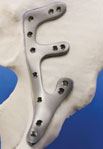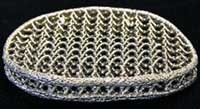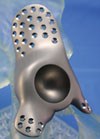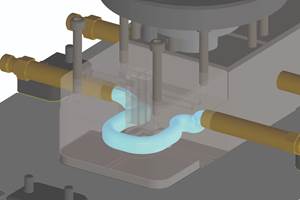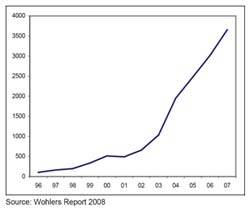Additive Manufacturing In Metal: New Option for Medical Applications
Parts produced by additive processes will require final machining or hand finishing, but allow significant flexibility in the manufacture of custom, short-run, complex or complicated-to-manufacture parts.
As rapid manufacturing applications gain a foothold for consumer products—such as customized footwear or high-complexity lighting fixtures—there has been a quiet adoption of some of these technologies within the medical sector.
Beyond creation of customized facsimile models of a patient’s anatomy, many companies are now using additive manufacturing technology to produce implantable components. Within the implant manufacturing sector the discussion continues for where additive metal fabrication technology fits. Easy applications are seen for custom or very short-run applications, but there are larger ideas coming.
Many are envisioning the day when additive metal machinery can produce with cost and time to rival traditional manufacturing technologies. “Demand-Based Manufacturing” could open the door for a dramatic shift in production techniques from traditional stockpiling to a system requiring much less inventory.
Several machine manufacturers promising “direct to metal” additive solutions now exist, each possessing positive and negative attributes. The company’s material offerings are now on the rise, especially in light of medical metals and alloys. This article will briefly review the current manufacturing techniques while introducing additive techniques and the materials that are possible today. The future is bright as the technology is in its infancy and applications are very promising.
Current Manufacturing Techniques and Application of RM
Production methods for surgical implants are today typically performed by making a near-net-shape part that is finished with specialized surface finishing or treatments for the desired surface, mechanical and aesthetic effects. Today’s tried and true techniques for production of these near-net-shape parts include investment casting, forging or machining. Each of these methods requires some follow-up finishing by hand or machine to achieve the final desired properties. Additive manufacturing in metal represents a new fourth option for production of orthopedic implants. Like today’s accepted methods, the parts produced by additive processes will require final machining or hand finishing, but allow significant flexibility of manufacture for custom, short-run, complex or otherwise complicated to manufacture parts.
Rapid manufacturing for any application offers key benefits to select areas of production. Within the medical realm this is very true, with RM offering advantages in the key areas of: (1) demand-based manufacturing in small to medium size quantities, (2) customized implants for a specific patient, (3) ease of manufacturing complex, freeform shapes and (4) an upgrade in material properties when compared to traditional manufacturing via investment casting. These will all be briefly defined with regard to surgical implant applications.
Demand-Based Manufacturing
Efficiency and flexibility offer great benefits in manufacturing in terms of increasing simplicity and decreasing inventory expense. Rapid manufacturing of metallic implants can offer the implant manufacturer a way to avoid two costly areas: (1) excess inventory and (2) the ability to make only what is needed.
When only 50 to 100 of a particular item are needed in a given year and the minimum order from a financial feasibility standpoint is 500, this creates a huge inefficiency. By offering the ability to make only the number that is needed a huge reduction in cost and inventory can be achieved.
Customized Implants
The ability to quickly and cost-effectively produce a custo-mized implant has always been appealing from a marketing and manufacturing standpoint. Historical barriers to this becoming a reality have included the inability to properly design a net shape
implant in a digital environment and the inability to manufacture
the implant in a digital manner. With the advent of better design tools and more options for output in manufacturing materials providing truly customized implants is possible today.
Complex Shape Manufacturing
As with all additive fabrication processes (both prototype and manufacturing) the ability to make ultimately complex objects is possible. This important factor is one that can add much value to the entire business of RM, and this is no different in medical uses for the technology.
Hard to manufacture designs are typically discarded in today’s manufacturing world in exchange for simplicity, which most times equals reduced cost. With RM one need not worry about complexity of design because of the additive nature of these new wave manufacturing processes.
A great example of the benefits of additive technologies is seen in construction of porous lattice structures. Many are now researching applications for porous constructs that are brand-new ideas for products not thought to be possible to manufacture using traditional processes. Again, these areas are key to finding value and financial gain from the use of RM in medicine.
Material Property “Upgrade”
Certain additive metal processes can be shown to produce material properties superior to their traditional manufacturing counterparts. For example, products that are typically produced in titanium alloy by investment casting have inferior properties to those produced from wrought material.
Casting has offered many benefits—one of which is directly parallel with its RM counterpart; the ability to produce very complex shapes easily. By discarding the investment cast method in favor of an additive method—in this case electron beam melting—one can realize better mechanical properties without sacrificing the ability to make a complex, freeform shape.
Currently Available Additive Metal Manufacturing Technology and Materials
Today’s additive metal manufacturing methods fall into two general categories:
- Those which use a laser-based melting system at room temperature with a shielding gas.
- Those which use an electron beam melting system at high temperature in a vacuum.
Each of today’s commercially available techniques has benefits and drawbacks.
Electron Beam Melting (EBM)1
The main difference between the EBM process and all of the other processes listed below is the energy source used to heat the metal powder during processing. The use of an electron beam, in lieu of a laser, provides much more energy. This allows for faster processing times, but more importantly EBM-produced parts have a more fully melted microstructure when compared to sintered structures. The process also builds parts in a vacuum at higher temperature, both of which are different as compared to laser-based processes. This technique is currently in use for production of serial and custom-made orthopedic implant components in titanium alloy with cobalt-chrome being used to a lesser degree. Commercially pure titanium also is available for processing using the EBM process.
Direct Metal Laser Sintering (DMLS)2
DMLS is arguably the most established direct metal fabrication technique. Depending on the particular model the process uses either a CO2 or ytterbium fiber laser to sinter fine metal powders into near fully dense components. Stainless steels and cobalt-
chrome components have been produced using this process, with recent efforts focusing on titanium and titanium alloys.
Selective Laser Melting (SLM)3
SLM is a process similar to DMLS. The use of finer metal powders, utilization of an infrared laser and slower processing times allows for almost 100 percent dense powder melting during the process. The process also is capable of producing components in finer detail as compared to other processes. Several materials are available from this process, including stainless steel, titanium and cobalt-chrome alloys.
LaserCUSING4
LaserCUSING is the name for a process that combines laser melting, laser marking and laser machining technologies. The process has been developed for several steel alloys. More advanced alloys such as Ti and colbalt-chrome alloys are under development. With the ability to laser machine a part following construction with laser melting,this technology is quite unique and may be a powerful solution in the future once more medical materials have been released.
Orthopedic Application Areas for RM
Custom Revision Prostheses
As the population ages, more and more patients are progressing to wear out their primary total joint prostheses and moving on to second, third and fourth revision prostheses. Each time the patient is operated on and each time an implant solution fails the available bone stock diminishes. Further complications exist if proper stabilization of the revision prostheses cannot be achieved. For this reason many orthopedic implant manufacturers supply custom-made revision prostheses to extend farther than traditional implants for fixation to surrounding bony structures. An example of a custom designed acetabular component produced using the electron beam melting process in titanium alloy is shown in Figure 1.
Custom Fracture Solutions
Many complex fractures are treated with surgical manipulation of the bony fragments with fixation by titanium plating. Since most of these procedures are done within a day or two of the accident they are accomplished with the use of standard size and shape titanium plates that are intra-operatively contoured to the patient’s anatomy. Custom design and production of these components with optimized designs is possible today as shown in Figure 2. This part was produced in titanium alloy using the electron beam melting process in full density. Today’s issue with extended timeframes is expected to be reduced making this application a potential reality in the years ahead.
Lower Volume Production: Hips, Knees
As orthopedic manufacturing companies move to more tailored solutions for specific patient size, sex, race, etc. they must carry more and more inventory of different shapes and sizes. This poses a significant problem for inventory and carrying cost. A more flexible manufacturing technique that allowed for creation of many shapes at one time offers the manufacturer a better way to control cost and reduce the high incidence of inventory sitting on the shelf collecting dust.
Complex Architectures Including Porous Structures
One of the most powerful aspects of additive manufacturing has always been the almost unlimited access to reproduce very complex designs. Most of today’s total joint prostheses (total hips, knees, shoulders, elbows, ankles) are moving to a “cementless” design. Cement has historically been used to enable short-term osseointegration of the implant to the surrounding bony surface. Fatigue strength of the cement materials is typically far inferior to the metallic components, which causes problems with the lifespan of the device thus being limited to the lifespan of the cement. Roughened surfaces of many types have been used to avoid the use of cement and today these are increasingly the product of choice for today’s younger patients. Additive manufacturing has the ability to not only make these complex bone integration surfaces, but also to integrate them onto the surface of a solid component of the same material produced at exactly the same time (see Figure 3).
Summary
The future looks bright for additive manufacturing in metals for the medical industry, especially for production of orthopedic implants. Two key benefits will ensure that this trend continues:
- The ability for flexible, additive metal manufacturing to help control inventory costs.
- The ability for additive manufacturing to produce parts that are otherwise impossible to produce.
The driving force behind the technology taking hold will be related to the second benefit, being able to make things that are either very difficult or impossible to manufacture. Custom products designed for a particular patient and scaffold devices of porous metal are two examples that will be driving the uptake of this technology. Cost savings and inventory reduction are secondary, but no less important, benefits that will arrive soon after.
References
- Electron Beam Melting (EBM) by Arcam AB (Sweden).
- Direct Metal Laser Sintering (DMLS) by EOS (Germany).
- Selective Laser Melting (SLM) by MCP Systems (Great Britain).
- LaserCUSING by Concept Laser (Germany).
Related Content
MMT Chats: 4 Keys to a Successful Mold-Building Operation: Innovation, Transparency, Accessibility and Relationship
MoldMaking Technology Editorial Director Christina Fuges chats with Steve Michon, co-owner of Zero Tolerance in Clinton Township, Michigan, about the excitement of solving problems, the benefits of showing gratitude, the real struggle with delegation and the importance of staying on top of technology. This episode is brought to you by ISCAR with New Ideas for Machining Intelligently.
Read MoreHow to Supply Cooling to Additive Tooling
Additive tooling provides limitless options for cooling a mold’s difficult-to-cool areas.
Read MoreMMT Chats: The Connection Between Additive Manufacturing Education and ROI
This MMT Chat continues the conversation with Action Mold and Machining, as two members of the Additive Manufacturing team dig a little deeper into AM education, AM’s return on investment and the facility and equipment requirements to implement AM properly.
Read MorePrecision Meets Innovation at IMTS 2024
After attending IMTS, it's clear that the integration of advanced technologies is ready to enhance precision, efficiency and automation in mold manufacturing processes. It’s a massive event, so here’s a glimpse of what the MMT team experienced firsthand.
Read MoreRead Next
The Impact and Evolution of Additive Fabrication
SAn executive summary of the annual Wohlers Report that provides quantitative and qualitative analysis on the additive fabrication industry worldwide.
Read MoreHow to Use Continuing Education to Remain Competitive in Moldmaking
Continued training helps moldmakers make tooling decisions and properly use the latest cutting tool to efficiently machine high-quality molds.
Read MoreAre You a Moldmaker Considering 3D Printing? Consider the 3D Printing Workshop at NPE2024
Presentations will cover 3D printing for mold tooling, material innovation, product development, bridge production and full-scale, high-volume additive manufacturing.
Read More



